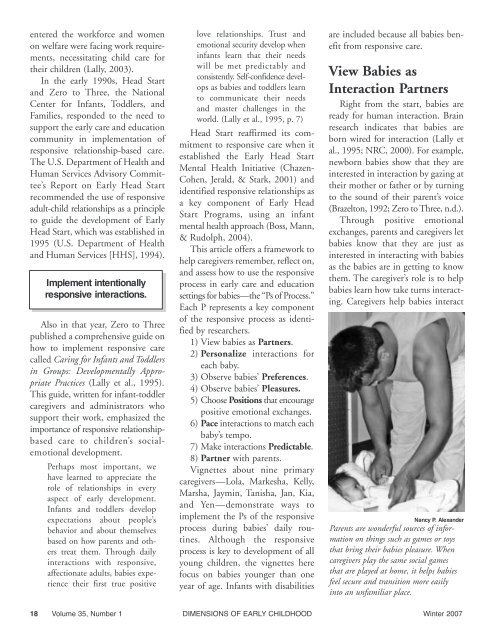Dimensions of Early Childhood - Southern Early Childhood ...
Dimensions of Early Childhood - Southern Early Childhood ...
Dimensions of Early Childhood - Southern Early Childhood ...
Create successful ePaper yourself
Turn your PDF publications into a flip-book with our unique Google optimized e-Paper software.
entered the workforce and women<br />
on welfare were facing work requirements,<br />
necessitating child care for<br />
their children (Lally, 2003).<br />
In the early 1990s, Head Start<br />
and Zero to Three, the National<br />
Center for Infants, Toddlers, and<br />
Families, responded to the need to<br />
support the early care and education<br />
community in implementation <strong>of</strong><br />
responsive relationship-based care.<br />
The U.S. Department <strong>of</strong> Health and<br />
Human Services Advisory Committee’s<br />
Report on <strong>Early</strong> Head Start<br />
recommended the use <strong>of</strong> responsive<br />
adult-child relationships as a principle<br />
to guide the development <strong>of</strong> <strong>Early</strong><br />
Head Start, which was established in<br />
1995 (U.S. Department <strong>of</strong> Health<br />
and Human Services [HHS], 1994).<br />
Implement intentionally<br />
responsive interactions.<br />
Also in that year, Zero to Three<br />
published a comprehensive guide on<br />
how to implement responsive care<br />
called Caring for Infants and Toddlers<br />
in Groups: Developmentally Appropriate<br />
Practices (Lally et al., 1995).<br />
This guide, written for infant-toddler<br />
caregivers and administrators who<br />
support their work, emphasized the<br />
importance <strong>of</strong> responsive relationshipbased<br />
care to children’s socialemotional<br />
development.<br />
Perhaps most important, we<br />
have learned to appreciate the<br />
role <strong>of</strong> relationships in every<br />
aspect <strong>of</strong> early development.<br />
Infants and toddlers develop<br />
expectations about people’s<br />
behavior and about themselves<br />
based on how parents and others<br />
treat them. Through daily<br />
interactions with responsive,<br />
affectionate adults, babies experience<br />
their first true positive<br />
love relationships. Trust and<br />
emotional security develop when<br />
infants learn that their needs<br />
will be met predictably and<br />
consistently. Self-confidence develops<br />
as babies and toddlers learn<br />
to communicate their needs<br />
and master challenges in the<br />
world. (Lally et al., 1995, p. 7)<br />
Head Start reaffirmed its commitment<br />
to responsive care when it<br />
established the <strong>Early</strong> Head Start<br />
Mental Health Initiative (Chazen-<br />
Cohen, Jerald, & Stark, 2001) and<br />
identified responsive relationships as<br />
a key component <strong>of</strong> <strong>Early</strong> Head<br />
Start Programs, using an infant<br />
mental health approach (Boss, Mann,<br />
& Rudolph, 2004).<br />
This article <strong>of</strong>fers a framework to<br />
help caregivers remember, reflect on,<br />
and assess how to use the responsive<br />
process in early care and education<br />
settings for babies—the “Ps <strong>of</strong> Process.”<br />
Each P represents a key component<br />
<strong>of</strong> the responsive process as identified<br />
by researchers.<br />
1) View babies as Partners.<br />
2) Personalize interactions for<br />
each baby.<br />
3) Observe babies’ Preferences.<br />
4) Observe babies’ Pleasures.<br />
5) Choose Positions that encourage<br />
positive emotional exchanges.<br />
6) Pace interactions to match each<br />
baby’s tempo.<br />
7) Make interactions Predictable.<br />
8) Partner with parents.<br />
Vignettes about nine primary<br />
caregivers—Lola, Markesha, Kelly,<br />
Marsha, Jaymin, Tanisha, Jan, Kia,<br />
and Yen—demonstrate ways to<br />
implement the Ps <strong>of</strong> the responsive<br />
process during babies’ daily routines.<br />
Although the responsive<br />
process is key to development <strong>of</strong> all<br />
young children, the vignettes here<br />
focus on babies younger than one<br />
year <strong>of</strong> age. Infants with disabilities<br />
are included because all babies benefit<br />
from responsive care.<br />
View Babies as<br />
Interaction Partners<br />
Right from the start, babies are<br />
ready for human interaction. Brain<br />
research indicates that babies are<br />
born wired for interaction (Lally et<br />
al., 1995; NRC, 2000). For example,<br />
newborn babies show that they are<br />
interested in interaction by gazing at<br />
their mother or father or by turning<br />
to the sound <strong>of</strong> their parent’s voice<br />
(Brazelton, 1992; Zero to Three, n.d.).<br />
Through positive emotional<br />
exchanges, parents and caregivers let<br />
babies know that they are just as<br />
interested in interacting with babies<br />
as the babies are in getting to know<br />
them. The caregiver’s role is to help<br />
babies learn how take turns interacting.<br />
Caregivers help babies interact<br />
Nancy P. Alexander<br />
Parents are wonderful sources <strong>of</strong> information<br />
on things such as games or toys<br />
that bring their babies pleasure. When<br />
caregivers play the same social games<br />
that are played at home, it helps babies<br />
feel secure and transition more easily<br />
into an unfamiliar place.<br />
18 Volume 35, Number 1 DIMENSIONS OF EARLY CHILDHOOD Winter 2007

















